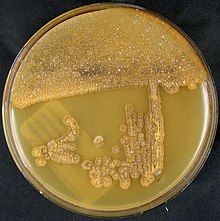Amycolatopsis orientalis is a Gram-positive bacterium in the phylum Actinomycetota.[1][2] It produces several substances with antimicrobial properties, including the antibiotic drug vancomycin.[3][4]
| Amycolatopsis orientalis | |
|---|---|

| |
| Scientific classification | |
| Domain: | Bacteria |
| Phylum: | Actinomycetota |
| Class: | Actinomycetia |
| Order: | Pseudonocardiales |
| Family: | Pseudonocardiaceae |
| Genus: | Amycolatopsis |
| Species: | A. orientalis
|
| Binomial name | |
| Amycolatopsis orientalis (Pittenger and Brigham 1956) Lechevalier et al. 1986[1]
| |
| Type strain | |
| ATCC 19795 CIP 107113 DSM 40040 IFO 12806 ISP 5040 JCM 4235 JCM 4600 NBRC 12806 NRRL 2450 UNIQEM 181 VKM Ac-866 | |
| Synonyms | |
| |
History
editA. orientalis was originally discovered by Edmund Kornfeld, an organic chemist at Eli Lilly and Company, in a soil sample gathered by a missionary from forests on the island of Borneo. The antibiotic vancomycin was first isolated from the bacteria in 1953.[4][5]
References
edit- ^ a b Lechevalier MP, Prauser H, Labeda DP, Ruan JS. (1986). "Two new genera of nocardioform actinomycetes: Amycolata gen. nov. and Amycolatopsis gen. nov". Int. J. Syst. Bacteriol. 36: 29–37. doi:10.1099/00207713-36-1-29.
- ^ Grayson, M. Lindsay (2012). Kucers' the use of antibiotics a clinical review of antibacterial, antifungal, antiparasitic and antiviral drugs (6th ed.). Boca Raton, Florida: CRC Press. p. 569. ISBN 9781444147520.
- ^ Kisil OV, Efimenko TA, Efremenkova OV (October 2021). "Looking Back to Amycolatopsis: History of the Antibiotic Discovery and Future Prospects". Antibiotics. 10 (10): 1254. doi:10.3390/antibiotics10101254. PMC 8532670. PMID 34680834.
There are more than 100 compounds of Amycolatopsis origin with described antibacterial activity and/or proven antibiotic biosynthesis gene presence. The most productive species are A. orientalis (12 antibiotics), A. mediterranei (5 antibiotics), and A. sulphurea (3 antibiotics).
- ^ a b Samanta, Indranil; Bandyopadhyay, Samiran (2019). Antimicrobial Resistance in Agriculture: Perspective, Policy and Mitigation. Elsevier Science. p. 205. ISBN 978-0-12-816523-2. Retrieved October 9, 2022.
Kornfield, an organic chemist at Eli Lilly, first isolated a bacterium namely Amycolatopsis orientalis (Streptomyces orientalis or Nocardia orientalis) from mud collected by a missionary from forests of Borneo island. A compound ('Mississippi mud' or compound 05,865) was extracted from the isolated bacteria and it was approved by FDA as vancomycin drug after clinical trials.
- ^ Wang, J.; Sintim, H.O. (2014). "Antibiotics That Disrupt Cell Wall and Bacterial Membrane Formation and Integrity". Reference Module in Biomedical Sciences. Elsevier. p. 7. doi:10.1016/b978-0-12-801238-3.00016-7. ISBN 9780128012383.
Vancomycin ... was first isolated in 1953 from a soil sample containing a bacterial species named Amycolatopsis orientalis.